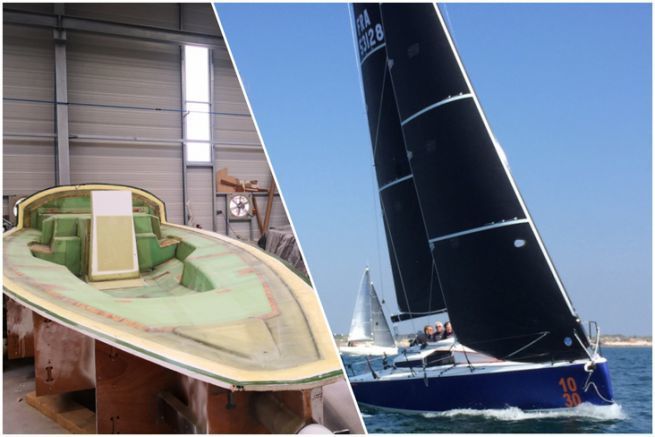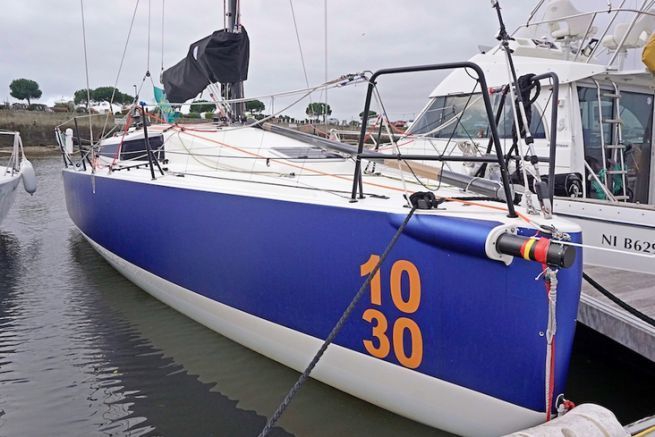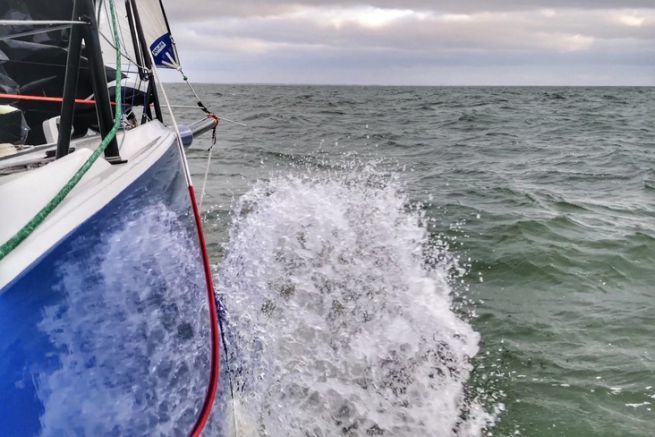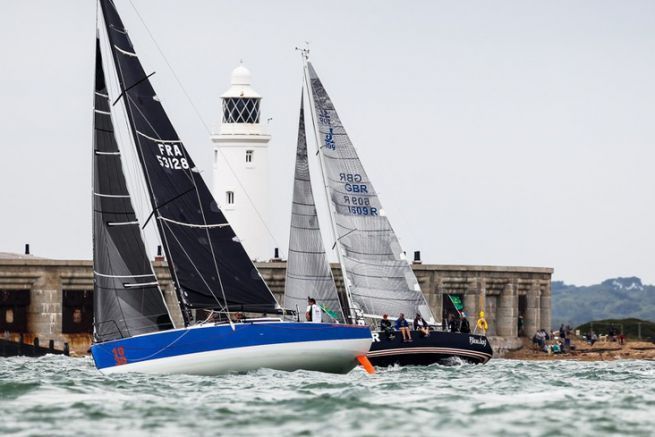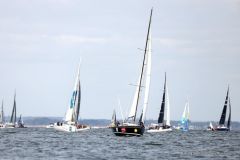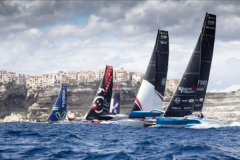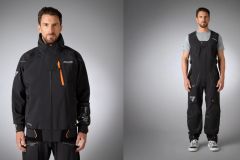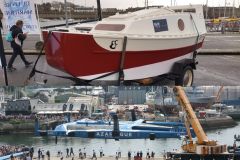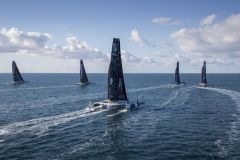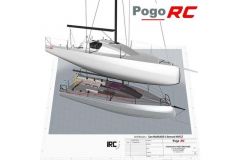On the Kernével pontoon in Larmor-Plage, we meet Jean-Pierre Kelbert who welcomes us aboard Léon, the JPK 1030 from the construction site. The boss leaves us the keys to his boat for the day and we'll try it out in duplicate. We will therefore be discovering the JPK without instructions for use and without a skipper, which is rare. Come to think of it, knowing that a good amateur regatta boat must be easy to understand and to operate, Jean-Pierre Kelbert must have confidence in his JPK 1030.
The JPK 1030 breathes competition
At first glance, the hull is powerful with high freeboards, the forward section is full and the almost vertical planking adds stiffness. The roof that juts out far towards the bow and the front portholes give an aggressive and very sporty look to the JPK 1030 . The attraction of the carbon makes its effect and the gaze is irresistibly drawn to the black mast with two layers of spreaders.
The spacious cockpit offers a functional and efficient organization. The helmsman benefits from all the mainsail adjustments and the crew member dedicated to manoeuvres has an ergonomic piano in front of him. Despite the presence of many ends, the simplicity that emanates from the JPK 1030 demonstrates a thorough study and knowledge of the requirements for dual and offshore navigation.
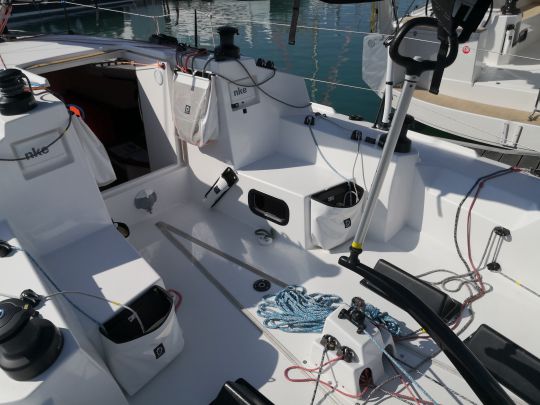
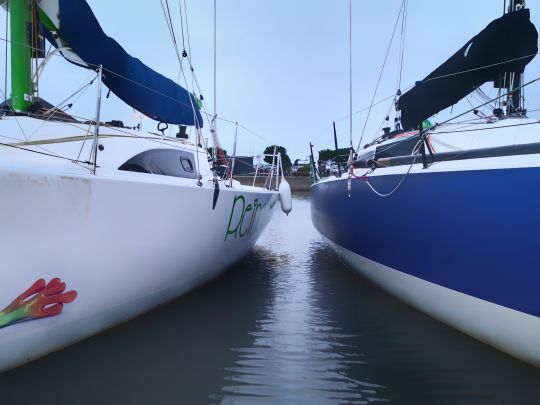
Note the difference in near-vertical freeboard between the JPK1030 (right) and the JPK1010 (left), which is less powerful. Sophia Von Fernbach
We choose the sails and go to sea
After a quick interior visit, Jean-Pierre helps us to select the sails to embark. In the Courreaux de Groix, the south-westerly wind is blowing at 12 to 18 knots. The weather is overcast, but in this month of January, we are lucky to have neither too much nor too little wind. We choose the J2 as our headsail, even if we are a bit under-canvas at the beginning. We also take on board the max spinnaker (A5) and a medium spinnaker (A3) in case the wind is stronger than expected.
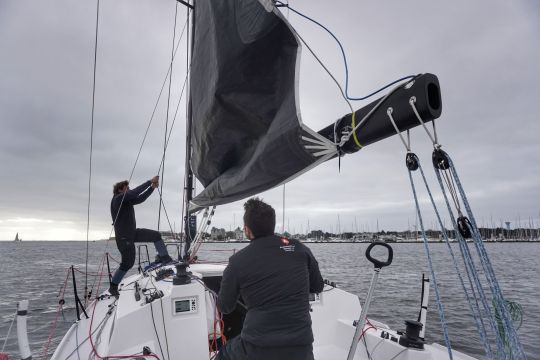
Sophia Von Fernbach
We install the beautiful dark membrane sails, the J2 mounted on a hollow Tuff Luff forestay and the semi-lattened mainsail is rigged on a luff tape. We adjust the underbeard so that the bowsprit can be pulled out to the maximum, i.e. 1.40 m beyond the bow. Finally, we leave the port of Kernével to listen to what the JPK 1030 has to tell us.
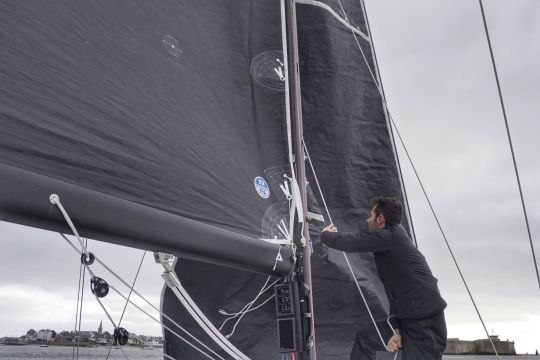
Sophia Von Fernbach
Nav' program for a trial run
It is through the West Pass that we will leave the roadstead of Lorient. Near the citadel of Port Louis, the incoming current is really strong, facing the wind we have to make a series of numerous tacks, perfect for warming up and getting familiar with the JPK 1030 .
Once out of the long channel, we will reach the Pen Men point, at the western end of the island of Groix. From here, we'll do a little reaching (crosswind), to feel the hull power. This so-called "bastard" look is essential to perform during long off-shore races.
Back at the tip of the island of Groix, we'll pull the first starboard spinnaker tack. Then, we'll gybe to reach the Southern Passage of the Lorient Channel, still under spinnaker, but on port tack.
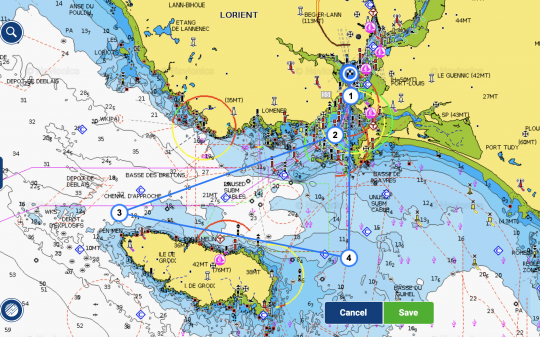
Upwind, power and control
We are taking advantage of the many turns imposed by the channel to exploit the JPK's good heading capabilities. The very uneven wind requires sail trimming, so the mainsail traveller and the mainsail traveller return to a small pod at the helmsman's feet. The backstay, also within reach, is powerful enough to bend the Axxon carbon mast. Unlike some of its competitors, JPK has chosen a simple backstay which prohibits the use of a real mainsail with a horn.
Upwind the sensations are there, the boat "speaks" well to her crew and we find a correct VMG at around 6.5 knots. In spite of the variable wind, under J2 and high GV, the boat's balance is very pleasant, and as soon as you pull a little on the stick, the speed increases very quickly above 7 knots.
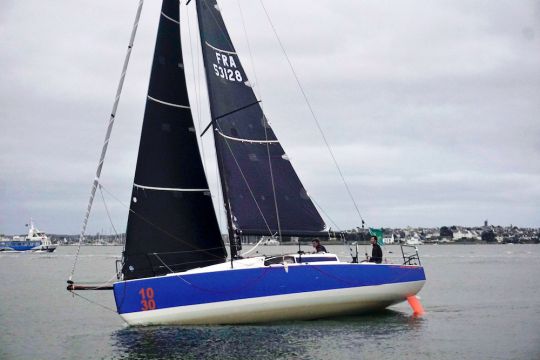
Sophia Von Fernbach
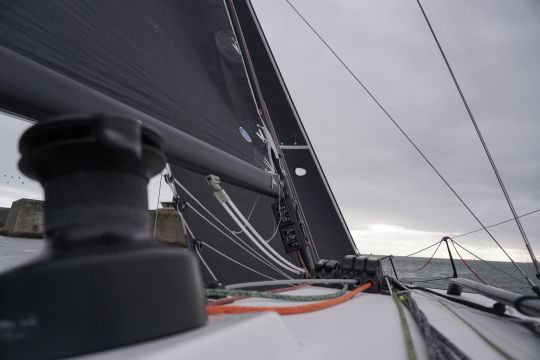
Sophia Von Fernbach
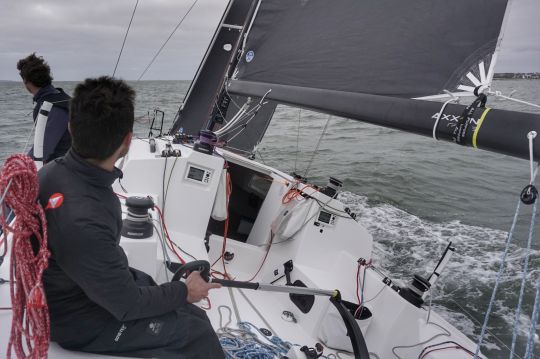
Sophia Von Fernbach
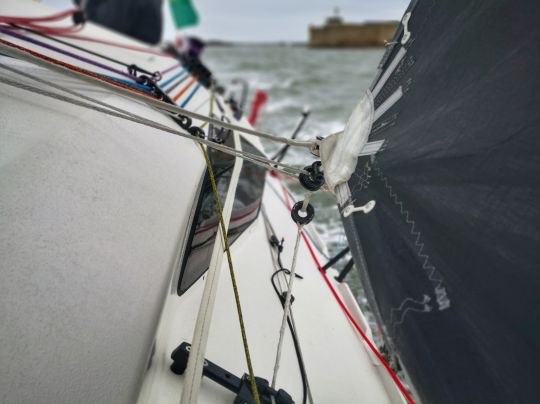
Solent adjustment: the roof stall and the 3D system allow to retract the front canopy pull point. Sophia Von Fernbach
On the stand, it's fast and it's accurate..
During the first tacks, we are quite surprised at how fast the boat turns. We attribute this in part to the brion that comes out clearly from the water and to a good distribution of the masses. This manoeuvrability will be much appreciated during the pre-start phases. Nevertheless, to tuck the solent in on time, we have to slow down the rotation a little, otherwise we'll come out too low on the other tack.
Double rudders give the helmsman smooth and precise steering with just the right amount of feedback. The tiller is fairly far forward in the cockpit. When turning, the helmsman instinctively passes over her without taking his eyes off the bow. At the bottom, large composite footrests allow the duo to sit side by side for long hours.
Upwind, it's slippery!
At the tip of Pen Men, the long-awaited moment to send the spinnaker has finally arrived and we're lucky, it's blowing at 18 knots. Upwind, the JPK 1030 reveals a playful character, as long as you loosen it up to get it to speed up. Thanks to its relatively steep hull and double rudders, the power of the asymmetrical spinnaker is easily controlled at the 1.40 m bowsprit.
At the tight drop, the wind now blowing at 22 knots offers us some nice flights under spinnaker. We catch the little waves and stay on it. At the bow, we see the foam of the wave appearing, which smokes and moves away from the bow as we accelerate. The precision of the bar allows us to dive into the small hollows while surfing. As we look for the limits, we realize that this IRC hull is still much more powerful than most of its sisters. The JPK is relatively light and with the help of a gust, we passed 14 knots, which is more than honourable for a 33-footer.
We gybe easily in 20 knots of wind. Thanks to the long bowsprit which moves the spinnaker away from the forestay, the spinnaker can be passed over the other tack without any particular effort. Once in scissors, at the next small wave it will be time to pass the mainsail.
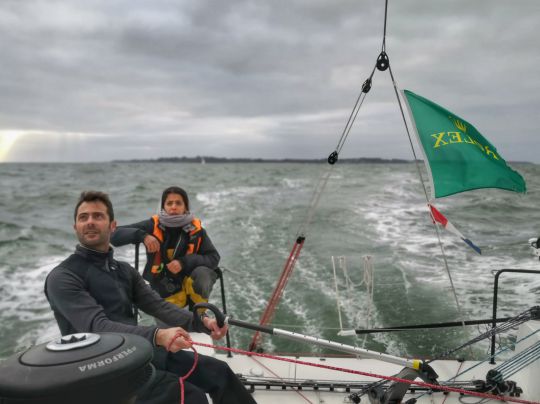
Even at high speed, the JPK1030 is perfectly controllable.
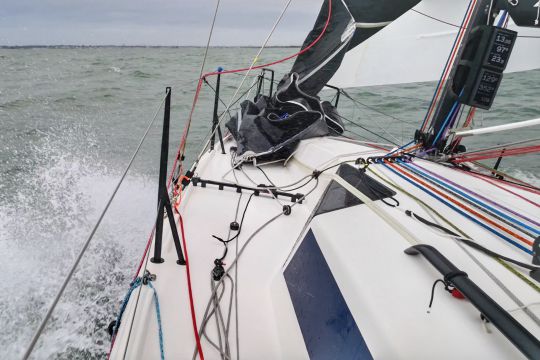
At 130° from the true wind, laughing at 23 knots, steady speed at 13 knots. Sophia Von Fernbach
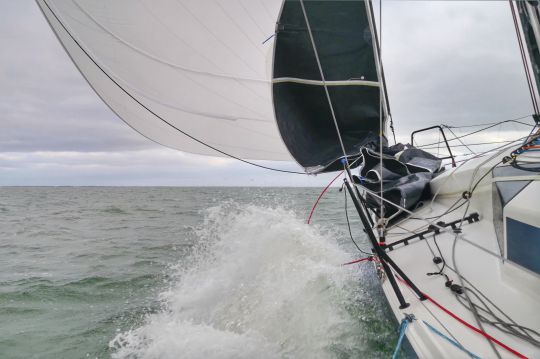
The JPK 1030 will certainly be formidable when dropped in the breeze. Sophia Von Fernbach
Code 0, the magic sail
As we got closer to the coast, the wind dropped to less than 8 knots. We end the day by rolling out the IRC code zero. This sail on the free luff, which is rigged at the end of the bowsprit, increases the area of the forward triangle significantly in light airs.
In order to meet the requirements of the IRC gauge, this sail has a somewhat special cut, because at 50% of the height it must be 75% of the maximum width. Nevertheless, it is a very appreciable additional surface to continue sailing on the sea made smooth by the absence of breeze. The day sets on the bay of Lorient and it is time to return to the port.
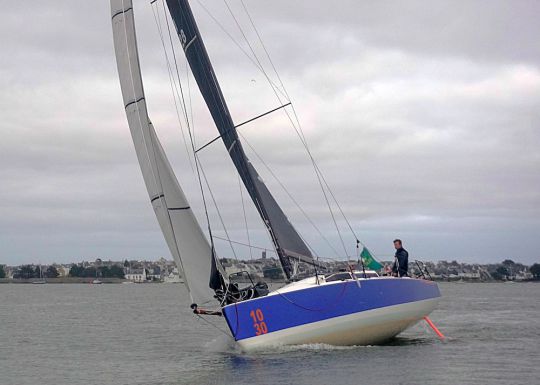
Sophia Von Fernbach
Ballasts to boost power
Upwind, the still light wind and the successive turns in the channel did not require the use of ballast tanks. It is still 300l of liquid to be moved from one side to the other and the JPK 1030 isn't that much of a canvas.
The ballast system is relatively simple. There is a central intake that pumps seawater to the selected tank. Large-diameter pipes run from tank to tank to move the liquid ballast. At the bottom of the cockpit, two telescopic rods are used to operate the valves. The filling, if the boat is flat, will take two minutes, more depending on the heel. During a tack, ballast transfer takes about 30 seconds.
On this boat, the role of the ballast is essential upwind, but it diminishes rapidly as it is lowered. According to Jean-Pierre Kelbert on the tight drop, his JPK 1030 would be faster sailing on the slice and without ballast, than flatter, but weighed down with 300 kg of ballast water.
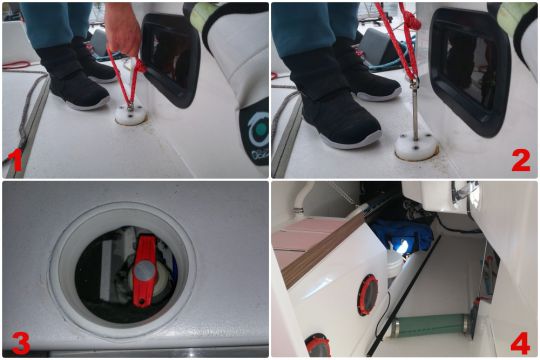
1 & 2. Ballast transfer control valve accessible at the bottom of the cockpit
3. The sofoscope valve located in the first step of the descent to draw sea water
4. Starboard ballast tank in the aft cabin with its transfer hose

